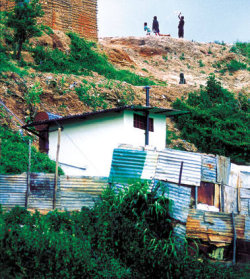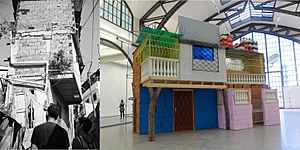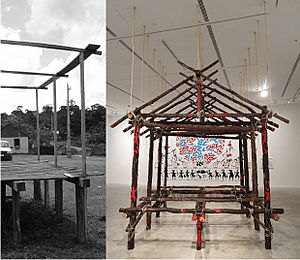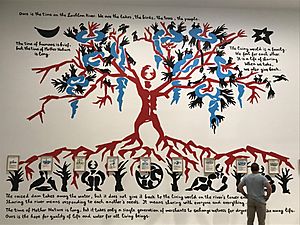Marjetica Potrč facts for kids
Quick facts for kids
Marjetica Potrč
|
|
|---|---|
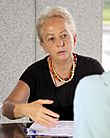
Marjetica Potrc in 2010
|
|
| Born | 1953 Ljubljana, Socialist Republic of Slovenia, Socialist Federal Republic of Yugoslavia
|
| Nationality | Slovenian |
| Occupation | Artist, Architect |
| Known for | Conceptual art, contemporary art, participatory design |
Marjetica Potrč (born 1953) is an artist and architect from Slovenia. She creates art, designs buildings, and studies how people live. Her work often involves projects built in real places, research, and drawings. She looks at modern ways of building, especially how we use energy and water.
Marjetica is very interested in how communities and governments can work together. She wants to make cities stronger and better for everyone. In her newer projects, she also explores the connection between people and nature. She supports the idea of protecting the rights of nature.
Her projects almost always involve working with others. This includes other artists, architects, and experts. She also works closely with local communities. The Curry Stone Foundation says she is great at finding the good things already in a community. She uses these strengths to help solve everyday problems.
Through these partnerships, she helps people find new ways to improve their living spaces. She calls this a "partnership in knowledge exchange." She believes it's important to create new connections. For example, linking environmentalists with Indigenous peoples. This helps create new ideas that go beyond old ways of thinking.
Contents
About Marjetica Potrč
Early Life and Education
Marjetica Potrč was born in Ljubljana, the capital city of Slovenia. At that time, Slovenia was part of a country called Yugoslavia. Her parents were both writers. Her father, Ivan Potrč, was a well-known Slovenian writer. Her mother, Branka Jurca, was a teacher and wrote many popular children's books.
Marjetica studied architecture at the University of Ljubljana. She earned her degree in 1978. Later, she also studied sculpture there, getting degrees in 1986 and 1988. In 1990, she moved to the United States.
Developing Her Art Style
During her time in the U.S., Marjetica created art installations that often featured different kinds of walls. One example is Two Faces of Utopia (1993). She once said, "I don't make objects. I build walls." This showed that her art was different from traditional sculpture. In 1994, she moved back to Ljubljana. Since then, her work has combined visual art, architecture, and social studies.
Marjetica Potrč's Work
On-Site Community Projects
In 2003, Marjetica Potrč spent six months in Caracas, Venezuela. She was there to study how people lived in informal parts of the city. Working with architect Liyat Esakov and local people, she created the Dry Toilet project. This was an eco-friendly toilet that didn't use water. It was installed in an area of Caracas that had no running water.
Dry Toilet is one of many projects where Marjetica works with communities. These projects focus on participatory design, meaning people help design them. They also deal with sustainability, especially how we use energy and water. Other important projects include Power from Nature (India and USA, 2005) and Rainwater Harvesting on a Farm in the Venice Lagoon (Italy, 2010).
Marjetica believes that when communities create their own sustainable solutions, it makes them stronger. This helps build a democracy where people have more power.
Teaching and Collaboration
From 2011 to 2018, Marjetica Potrč was a professor in Hamburg, Germany. She taught a class called "Design for the Living World." In this class, she and her students worked on design projects with communities around the world. They saw themselves as helpers and partners. They developed new ways of working together, like "rituals of transition."
Marjetica explained that her role is to help create connections. She sees these projects as a "laboratory" where everyone tests ideas and shares knowledge. She believes artists and designers should help create new values for our modern world.
A notable project was The Soweto Project (2014). She and her class spent two months in Soweto, South Africa. They worked with local residents to turn a messy public space into a useful community area.
Since 2010, Marjetica has also worked with the design group Ooze. These projects often focus on cleaning water. Examples include Between the Waters: The Emscher Community Garden (Germany, 2010). Here, they built a full sustainable water system. Another project was Of Soil and Water: King's Cross Pond Club (London, 2015). They created a natural swimming pond with its own tiny ecosystem.
Architectural Case Studies
Marjetica Potrč also creates large art installations she calls "architectural case studies." These are like "theatrical objects" that show real-life building practices. They explore how buildings relate to the environment, society, and politics. She always shows where the idea came from, often with a photo of the original place.
For example, Hybrid House: Caracas, West Bank, West Palm Beach (2003) showed how three different communities deal with space, safety, energy, and water. These communities were a neighborhood in Caracas, a Jewish settlement, and a temporary housing area in Florida.
Another study, Duncan Village Core Unit (2002), showed how a city government and its residents can work together. The city provided basic services like water and sewage. Then, new residents built their homes around these services. Later versions of this artwork showed how these homes grew with new parts like water tanks and gardens.
Marjetica described Caracas: Growing Houses (2012) as a "three-dimensional portrait of an informal city."
It showed two self-built houses from a Caracas neighborhood. She explained that these houses "grow" because people build them themselves. They also change as families grow and interact. She says, "Existence is always a coexistence."
The School of the Forest/Miami Campus (2015) was a study of a community center in the Amazon rainforest. It was inspired by a project that combined local knowledge with scientific knowledge. In the museum, lectures and workshops were held in the building she created.
The artwork The House of Agreement Between Humans and the Earth (2022) was inspired by Amazonian stilt houses. It's a simple wooden house held together by ropes. It shows how buildings and social ideas can connect with nature. The base represents the earth, supporting agreements between people and nature. Ropes reaching the ceiling show how humans depend on nature. Drawings on the house show the fight for the rights of nature in Australia. This work was shown at the 23rd Biennale of Sydney.
Research and Visual Essays
Since 2003, Marjetica Potrč has done many research projects. She often studies places that are changing and finding new ways to live. Some of her important research includes projects in the Amazon (2006) and studying water issues in New Orleans after Hurricane Katrina (2007). She also worked on a project about the rights of rivers for the 23rd Biennale of Sydney (2022). In this project, she worked with Wiradjuri elder Ray Woods. Working with others is a key part of almost all her research.
These research projects lead to her architectural case studies and also to visual essays and large diagrams. These drawings help her share her findings with more people. Her visual essays tell stories using simple pictures and text. They explain the challenges and solutions of the communities she studies. Examples include The Struggle for Spatial Justice (2005) and The Rights of a River (2021). Her diagrams include The Great Republic of New Orleans (2007) and The World in the Age of Stories (2020). These diagrams are often drawn directly on walls in exhibitions.
Exhibitions and Awards
Major Exhibitions
Marjetica Potrč's work has been shown in many big international art shows. These include:
- Skulptur Projekte Münster (1997)
- São Paulo Biennial (1996, 2006)
- Venice Biennale of Art (1993, 2003, 2009)
- Biennale of Sydney (2022)
Since 2003, she has regularly shown her art at Galerie Nordenhake in Berlin and Stockholm.
Solo Exhibitions
She has also had many important solo exhibitions, where only her work is shown. Some of these include:
- Hugo Boss Prize 2000: Marjetica Potrč, Guggenheim Museum, New York (2001)
- Urgent Architecture, List Visual Arts Center, MIT, Massachusetts (2004)
- Forest Rising, The Curve at the Barbican Art Gallery, London (2007)
- The School of the Forest/Miami Campus, Pérez Art Museum, Miami (2015)
- Shelter: Closed and Open, VISUAL Centre for Contemporary Art, Ireland (2018)
Awards and Recognition
Marjetica Potrč has received several important awards for her work:
- The Medal of Merit of the Republic of Slovenia (2023)
- Curry Stone Design Prize (2008)
- Hugo Boss Prize (2000), given by the Guggenheim Museum
- Pollock-Krasner Foundation grants (1993 and 1999)
See also
 In Spanish: Marjetica Potrč para niños
In Spanish: Marjetica Potrč para niños


